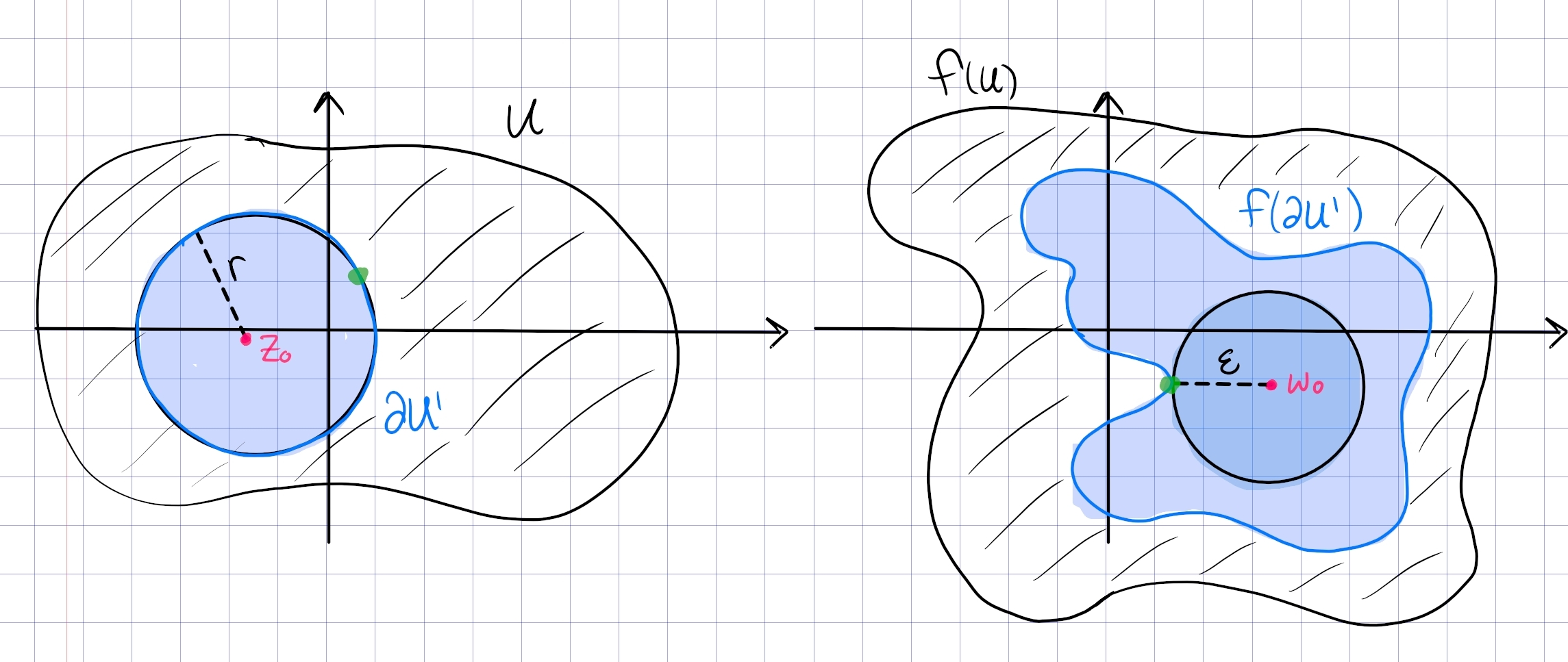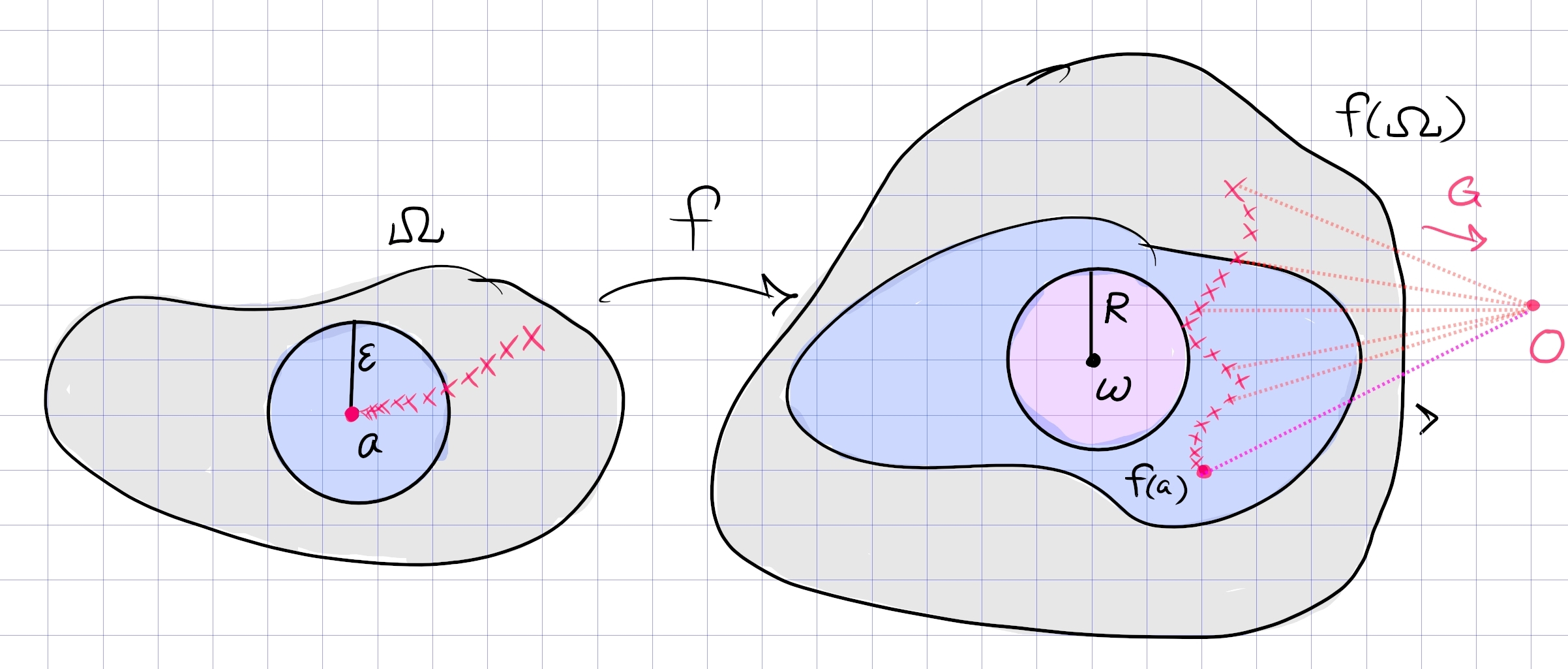Spring 2020.6 (Prove the open mapping theorem) #complex/qual/completed
Prove the open mapping theorem for holomorphic functions: If \(f\) is a non-constant holomorphic function on an open set \(U\) in \(\mathbb{C}\), then \(f(U)\) is also an open set.
Idea:

Let \(f: U\to {\mathbb{C}}\). Pick \(w_0\in W\) with \(f(z_0) = w_0\) for some \(z_0\in U\); we want to show that \(w_0\) is an interior point of \(f(U)\), so we’re looking for a disc containing \(w_0\) and contained in \(f(U)\).
Write \begin{align*} g_0(z) \coloneqq f(z) - w_0 ,\end{align*} so \(g_0\) is holomorphic and has a zero at \(z_0\). Since zeros of holomorphic functions are isolated, there is some \(U' \coloneqq{\mathbb{D}}_r(z_0)\) where \(g_0\) is nonvanishing. The claim is that if we choose \({\varepsilon}\) small enough, we can arrange so that \(W_{\varepsilon}\coloneqq{\mathbb{D}}_{\varepsilon}(w_0) \subseteq f(U)\). This will follow if for every \(w\in W_{\varepsilon}\), the equation \(f(z) = w\) has a solution in \(U\), i.e. Define a function that counts the number of zeros: \begin{align*} F(w) &\coloneqq{1\over 2\pi i}\int_{{{\partial}}U' } {f(z) \over f(z) - w_1 }\,dz\\ &= {1\over 2\pi i}\int_{{{\partial}}U' } {{\frac{\partial }{\partial z}\,}\qty{f(z) - w} \over f(z) - w }\,dz\\ &= {\sharp}Z(f(z) - w, U' ) ,\end{align*} which is the number of zeros of \(f(z) - w\) in \(U'\) by the argument principle. Now \(F\) is a \({\mathbb{Z}}{\hbox{-}}\)valued function, and the only obstruction to continuity is if \(f(z) - w = 0\) in the integrand for some \(z\). The claim is that \({\varepsilon}\) can be chosen such \begin{align*} z\in {{\partial}}U' \implies {\left\lvert {f(z) - w} \right\rvert} > 0 \qquad \forall w\in W_{\varepsilon} .\end{align*} The theorem then follows immediately: \(F(w): U' \to W_{\varepsilon}\) is a continuous and \({\mathbb{Z}}{\hbox{-}}\)valued, thus constant. Then noting that \(F(w_0) = 1\) since \(z_0\in U'\) and \(w_0\in W_{\varepsilon}\), we have \(F\equiv 1 > 0\) for all \(w\).
Choose \begin{align*} {\varepsilon}\coloneqq\min_{z\in {{\partial}}U'}{\left\lvert {f(z) - w_0} \right\rvert} .\end{align*} Now if \({\left\lvert {w-w_0} \right\rvert} < {\varepsilon}\) and \({\left\lvert {z-z_0} \right\rvert} = r\), we have \({\left\lvert {f(z) - w} \right\rvert} > {\varepsilon}> 0\).
Fall 2019.4, Spring 2020 HW 3 SS 3.8.14, Tie’s Extras Fall 2009, Problem Sheet (Entire univalent functions are linear) #complex/qual/completed
Let \(f: \mathbb{C} \rightarrow \mathbb{C}\) be an injective analytic (also called univalent) function. Show that there exist complex numbers \(a \neq 0\) and \(b\) such that \(f(z)=a z+b\).
Hint: Apply the Casorati-Weierstrass theorem to \(f(1/z)\).
Note that \(f\) is non-constant, since a constant function is extremely non-injective. Consider the singularity at \(\infty\):
-
If it is removable, then \(f\) is bounded outside of a large disc, and bounded inside of it as a continuous function on a compact set, making \(f\) entire and bounded and thus constant by Liouville.
-
If it is essential, then by Casorati-Weierstrass there is a large disc of radius \(R\) such that \(f(\mkern 1.5mu\overline{\mkern-1.5mu{\mathbb{D}}_R\mkern-1.5mu}\mkern 1.5mu^c) \subseteq {\mathbb{C}}\) is dense. By the open mapping theorem, \(f({\mathbb{D}}_R) \subseteq {\mathbb{C}}\) is open, so by density it intersects \(f(\mkern 1.5mu\overline{\mkern-1.5mu{\mathbb{D}}_R\mkern-1.5mu}\mkern 1.5mu^c)\), but \({\mathbb{D}}_R \cap\mkern 1.5mu\overline{\mkern-1.5mu{\mathbb{D}}_R\mkern-1.5mu}\mkern 1.5mu^c\) is empty so this contradicts injectivity.
So we can conclude \(\infty\) is a pole of some order \(N\), so \(f\qty{1\over z} = \sum_{0\leq k\leq N} c_k z^{-k}\) and thus \(f(z) = \sum_{0\leq k\leq N} c_k z^k\) is a polynomial of degree \(N\). However, a polynomial of degree \(N\) is generically \(N\)-to-one locally, so injectivity forces \(N=1\) and \(f(z) = c_0 + c_1 z\), where \(c_1\neq 0\) since \(f\) is nonconstant.
Write \(g(z) \coloneqq f(1/z)\), which has a singularity at \(z=0\). The claim is that this is a pole.
If \(z=0\) is a removable singularity, \(g\) is bounded on some closed disc \({\left\lvert {z} \right\rvert} \leq {\varepsilon}\), so \(f\) is bounded on \({\left\lvert {z} \right\rvert} > {\varepsilon}\). Moreover \(f\) is continuous and \({\left\lvert {z} \right\rvert}\leq {\varepsilon}\), \(f\) is bounded on this disc. This makes \(f\) an entire bounded function and thus constant by Liouville, contradicting injectivity.
If \(z=0\) is essential, then by Casorati-Weierstrass pick a punctured disc \(D = \left\{{{\left\lvert {z} \right\rvert} \leq {\varepsilon}}\right\}\) where \(g(D)\) is dense in \({\mathbb{C}}\). Writing \(D^c \coloneqq\left\{{{\left\lvert {z} \right\rvert} > {\varepsilon}}\right\}\), this means that \(f(D^c)\) is dense. But \(U\coloneqq\left\{{{\left\lvert {z} \right\rvert} < {\varepsilon}}\right\}\) is open and by the open mapping theorem \(f(U)\) is open, so by density there is a point \(w\in f(D^c) \cap f(U)\) while \(U \cap D^c = \emptyset\), again contradicting injectivity.
So \(z=0\) is a pole of \(g\), and \(g\) admits a Laurent expansion \begin{align*} g(z) = \sum_{k\geq -N} c_k z^k .\end{align*} Since \(f\) is entire, it equals its Laurent expansion at \(z=0\), so equating the two series yields \begin{align*} f(z) = \sum_{k\geq 0} d_k z^k &\implies g(z) = \sum_{k\geq 0} {d_k \over z^k} = \sum_{1\leq k\leq N} {c_k\over z^k} + \sum_{k\geq 0} c_k z^k \\ &\implies \sum_{k\geq 0} c_k z^k = 0 \\ &\implies f(z) = \sum_{0\leq k \leq N} c_k z^k ,\end{align*} making \(f\) a polynomial of degree at most \(N\).
Now \(f\) can not be degree zero, since constant maps are not injective. Moreover \(f\) can not be degree \(N\geq 2\), since any polynomial of degree \(N\) has \(N\) roots in \({\mathbb{C}}\) by the fundamental theorem of algebra, and any two distinct roots will be points where injectivity fails. Finally, ruling out the case of roots with multiplicity, if \(f(z) = c(z-a)^N\), then \(f\) has exactly \(N\) preimages in a neighborhood of \(a\). Letting \(p\) be any such point, we can find \(N\) complex points mapping to it: \begin{align*} p = c(z-a)^N &\implies {p\over c} = (z-a)^N \\ &\implies \qty{p\over c}^{1\over N}\zeta_N^k = z-a \quad k=0,1,\cdots, n-1 \\ &\implies z_k\coloneqq\qty{p\over c}^{1\over N}\zeta_N^k + a \xrightarrow{f} p .\end{align*}
So \(f\) must be degree exactly 1, i.e. \(f(z) = az+b\).
Tie’s Extra Questions: Spring 2015 #complex/exercise/completed
-
Let \(f\) be analytic in \(\Omega: 0<|z-a|<r\) except at a sequence of poles \(a_n \in \Omega\) with \(\lim_{n \rightarrow \infty} a_n = a\). Show that for any \(w \in \mathbb C\), there exists a sequence \(z_n \in \Omega\) such that \(\lim_{n \rightarrow \infty} f(z_n) = w\).
-
Explain the similarity and difference between the above assertion and the Weierstrass-Casorati theorem.
DZG: I think it’s also necessary to state that \(z_n \to a\).

As in the proof of Casorati-Weierstrass, fix \(w\) and suppose toward a contradiction that no sequence sequence exists. Then there is some \({\varepsilon}, R\) such that \begin{align*} f({\mathbb{D}}_{\varepsilon}(a)) \subseteq {\mathbb{D}}_R(w)^c ,\end{align*} for otherwise one could construct the desired sequence. In particular, \({\left\lvert {f(z) - w} \right\rvert} > R\) for \({\left\lvert {z-a} \right\rvert} < {\varepsilon}\), so define \begin{align*} G(z) \coloneqq{1\over f(z) - w} \implies {\left\lvert {G(z)} \right\rvert} \leq R^{-1}< \infty \qquad \text{in }{\mathbb{D}}_{\varepsilon}(a) .\end{align*} Since \(G\) is bounded in this disc, any singularities here must be removable. Since the \(a_k\) are poles of \(f\), they are zeros of \(G\) – this is because if \({\left\lvert {f(z)} \right\rvert}\to\infty\) as \(z\to a_k\) then \({\left\lvert {G(z)} \right\rvert}\to 0\). So \(G(a_k) = 0\) for all \(k\) and \(G\) extends holomorphically over the removable singularity \(a\), and by continuity must satisfies \(G(a) = 0\). But now \(G\) is zero on a set with a limit point, hence \(G\equiv 0\) by the identity principle. This is a contradiction since if \(G\equiv 0\) on an open set, \(f\) has poles on an open set, contradicting that \(f\) is holomorphic on \(\Omega\).
The difference to Casorati-Weierstrass: the singularity at \(a\) is not essential, since in particular it is not isolated. The conclusion is nearly the same though: this says that every \(w\in {\mathbb{C}}\) is a limit point for \(f(\Omega)\), so \(w\) is in the closure of \(f(\Omega)\), making the image dense in \({\mathbb{C}}\).
Dense images #complex/exercise/work #stuck
Suppose \(f: {\mathbb{H}}\cup{\mathbb{R}}\to {\mathbb{C}}\) satisfies the following:
- \(f(i) = i\)
- \(f\) is continuous
- \(f\) is analytic on \({\mathbb{H}}\)
- \(f(z) \in {\mathbb{R}}\iff z\in {\mathbb{R}}\).
Show that \(f({\mathbb{H}})\) is a dense subset of \({\mathbb{H}}\).
Ideas:
- If an entire function doesn’t have dense image, it’s constant by Liouville using the proof idea of Casorati-Weierstrass.
- Conjugate \(f\) by \(T:{\mathbb{H}}\to {\mathbb{D}}\) where \(T(z) = {z-i\over z+i}\), then \(\tilde f(0) = 0\)
- Use that \(T({\mathbb{R}}) = S^1\), so \({\left\lvert {\tilde f(z)} \right\rvert} = 1\) when \({\left\lvert {z} \right\rvert} = 1\).
- Schwarz reflection applies to \(\tilde f\) to define an entire function – if \(f\) isn’t dense, then the extension of \(\tilde f\) isn’t dense…?
- No clue how to use \(f(i) = i\), although it implies \(\tilde f(0) = 0\) and Schwarz applies.
Tie’s Extra Questions: Spring 2015 #complex/exercise/work
Let \(f(z)\) be an analytic function on \({\mathbb C} \backslash \{ z_0 \}\), where \(z_0\) is a fixed point. Assume that \(f(z)\) is bijective from \({\mathbb C} \backslash \{ z_0 \}\) onto its image, and that \(f(z)\) is bounded outside \(D_r(z_0)\), where \(r\) is some fixed positive number. Show that there exist \(a, b, c, d \in \mathbb C\) with \(ad-bc \neq 0\), \(c \neq 0\) such that \(\displaystyle f(z) = \frac{az + b}{cz + d}\).